15-Minute Spicy & Cold Bibim Kimchi Noodles Recipe.
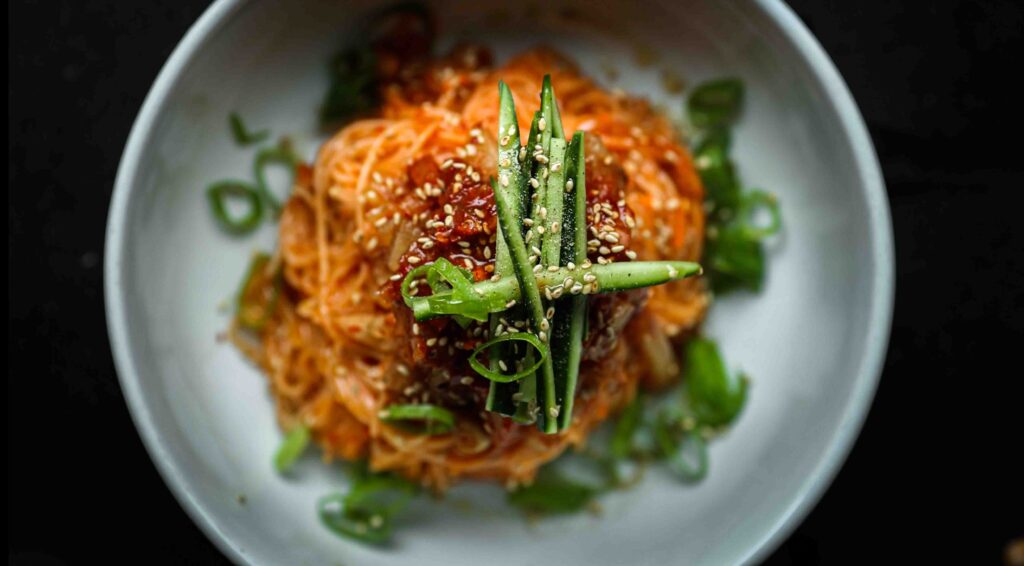
Spicy. Refreshing. Addictive.
Kimchi noodles.
As summer nears, millions of people in Korea will partake in the collective SLURP of cold Korean kimchi noodles or “kimchi guksu.”
This kimchi noodles recipe is one of my favorite Korean recipes because it is absolutely delicious and sinfully easy to make.
From start to finish, it’ll take you less than 15 minutes! I guarantee you, this easy recipe will become a new favorite.
So, without further ado, let’s get into it!
- What are Bibim Kimchi Noodles or Kimchi Bibim-Guksu?
- How to Eat and Serve this Kimchi Noodles Recipe.
- Key Ingredients Notes on Substitutions for this Kimchi Noodles Recipe.
- How to Make this Kimchi Noodles Recipe.
- Fun Add-Ons to this Kimchi Noodles Recipe.
- Frequently Asked Questions.
- Recipe Card.
- Questions & Comments
Disclaimer: Some of the links in this post may be affiliate links for products I use and love. If you make a purchase after clicking one of those links, I may earn a small affiliate commission, perhaps enough to buy some extra gochujang or gochugaru 🙂
What are Bibim Kimchi Noodles or Kimchi Bibim-Guksu?
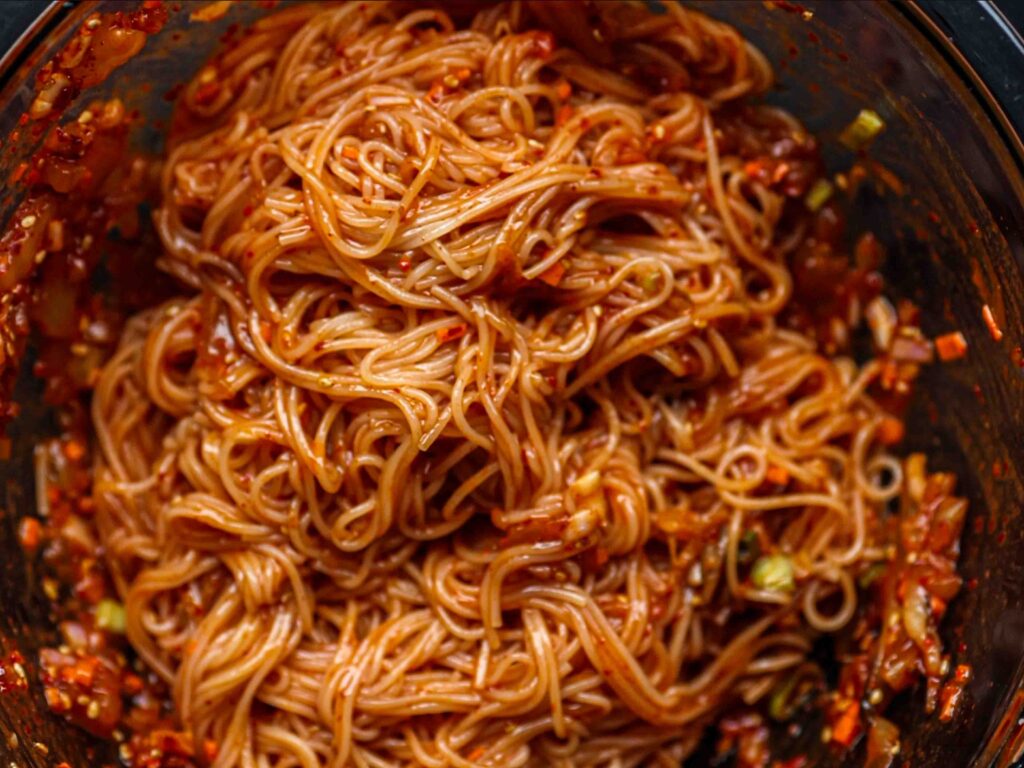
“Bibim Kimchi Noodles.” Let’s inspect each of these words separately:
“Bibim” or 비빔 literally translates into “mixed.” You may have heard this phrase attached to the eponymous “Bibim-bap,” which refers to “mixed rice.” If you are familiar with bibimbap, then many of the flavors and textures of this kimchi noodles recipe will be familiar. The sauce is very similar, with a base of gochujang paste, and the noodles are enriched with a generous dollop of toasted sesame oil and toasted sesame seeds.
“Kimchi” of course refers to, well, kimchi–the undisputed icon of Korean food. I suppose you can really use whatever kind of kimchi you want, but, traditionally, bibim kimchi noodles are made using aged napa cabbage kimchi (as opposed to radish kimchi). What do I mean by “aged”? You definitely don’t want to use kimchi that you just made. This kimchi noodles recipe is for the kimchi that’s been sitting idly in your fridge for the past several weeks, if not months. The “oomph” of flavor will pair well with the sesame oil, gochujang, and soy sauce to create a dynamic sauce for your noodles.
Speaking of which, “noodles” refers to Korean wheat noodles or “somyeon” (소면). Thus, when you hear “kimchi bibim guksu” or “cold kimchi noodles,” do not confuse this dish with a kimchi ramen recipe or kimchi udon (both of which are delicious, btw, just not this dish). Kimchi bibim guksu also shouldn’t be confused with another popular cold noodle dish in Korean cuisine: naengmyeon. Unlike naengmyeon, the somyeon for this kimchi noodles recipe is made out of wheat, not buckwheat (as is the case with naengmyeon).
As the name suggests, this kimchi noodles recipe is typically served cold. Other than cooking the noodles, there’s no other cooking involved. Even so, these kimchi noodles will pack some heat, utilizing gochujang, Korean red pepper power or gochugaru, and spicy kimchi.
How to Eat and Serve this Kimchi Noodles Recipe.
As I talk about in my cookbook, The Korean Vegan Cookbook: Recipes and Stories from Omma’s Kitchen, the overwhelming majority of Korean meals begin with a bowl of rice, a hearty protein or “main dish,” surrounded by several small bowls or pots containing “banchan” or “side dishes.” The only major exception to that rule is when you’re eating noodles.
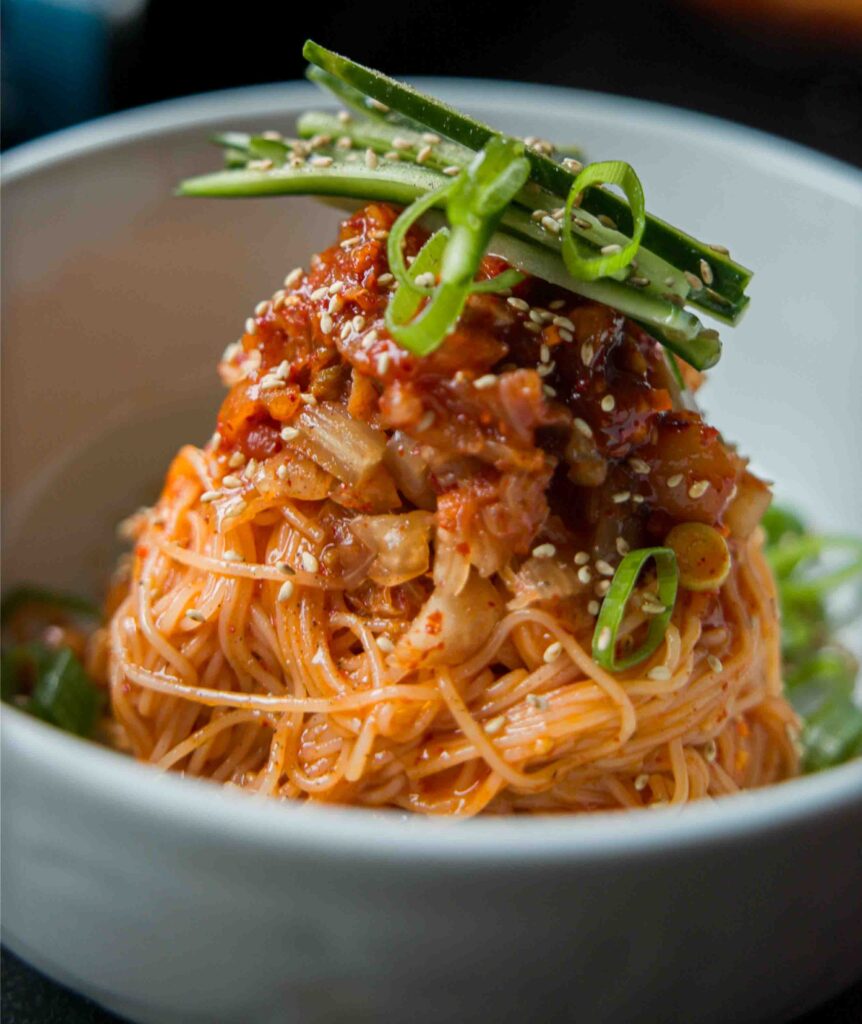
Other than japchae (which is considered to be a side dish), noodles are served without rice and usually with a minimal fleet of banchan. Moreover, noodles are almost never served with jjigae (stew) or guk (soup). Rather, they are served and enjoyed as a stand-alone dish with kimchi or danmuji (pickled radish).
Kimchi noodles are designed to be a quick and easy meal and this kimchi noodles recipe is no different. Whether you’re in need of an easy weeknight meal after a long day at work or a post-midnight snack for that unearthly craving that attacks all of us every once in awhile, a bowl of kimchi noodles will hit the spot without a lot of work.
Key Ingredients Notes on Substitutions for this Kimchi Noodles Recipe.
The following are some recommended substitutions to certain ingredients for this kimchi noodles recipe:
- Somyeon or Thin Korean wheat noodles. This kimchi noodles recipe, like most other bibim kimchi noodles recipe, calls for somyeon or very skinny Korean wheat noodles. You can find these easily at any Korean grocery store or other Asian market or online. If you can’t find somyeon or just want to make this dish right now and don’t have somyeon, you can substitute with angel hair or capellini pasta. You can even substitute with a gluten-free version made of rice flour.
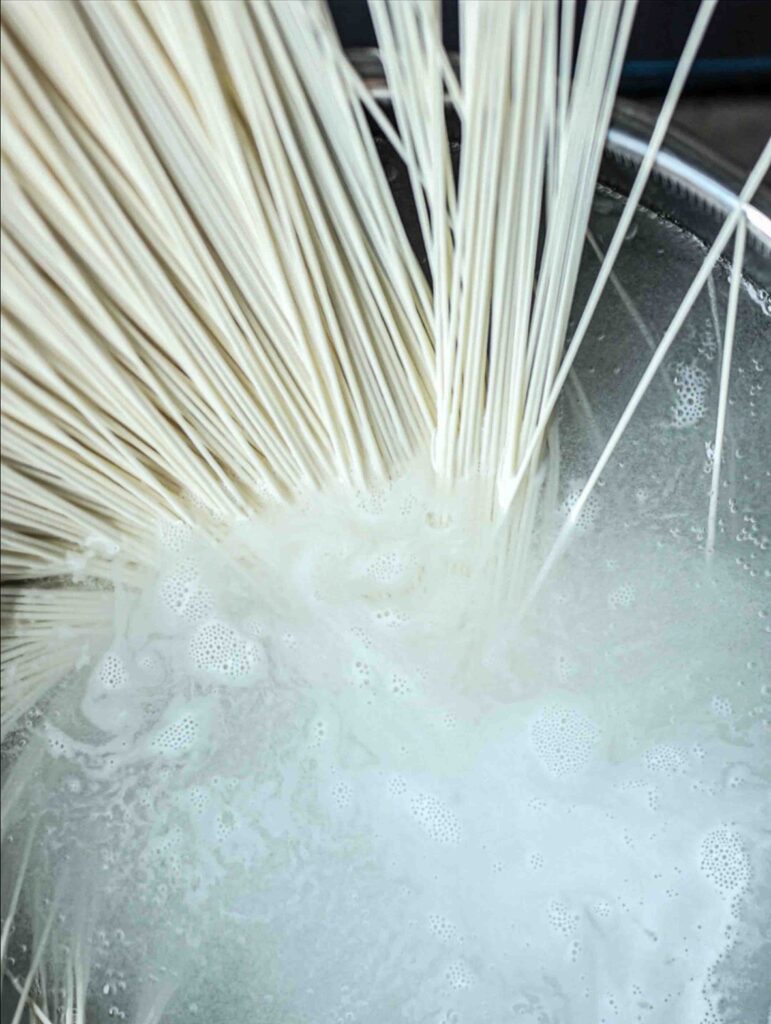
- Soy Sauce. Soy sauce will add deep umami to this kimchi noodles recipe, so get your hands on a good one the next time you’re out shopping for Korean ingredients. If you want to keep this recipe entirely gluten-free (while using the above mentioned gluten-free noodles), makes sure to use a good gluten-free soy sauce. If you are allergic to soy, there are some great no-soy alternatives, including this no-soy, gluten-free seasoning sauce. You can, of course, also use coconut aminos.
- Kimchi. If you can, your best bet is to use homemade kimchi. Why? First, it tastes better. Second, you’ll have ample kimchi juice to add to your sauce. That said, if you don’t have homemade kimchi handy and don’t have time to make some, just pick up a jar of your favorite store-bought kimchi–one that looks juicy. Please don’t ask me what you can substitute for kimchi for this KIMCHI noodles recipe.
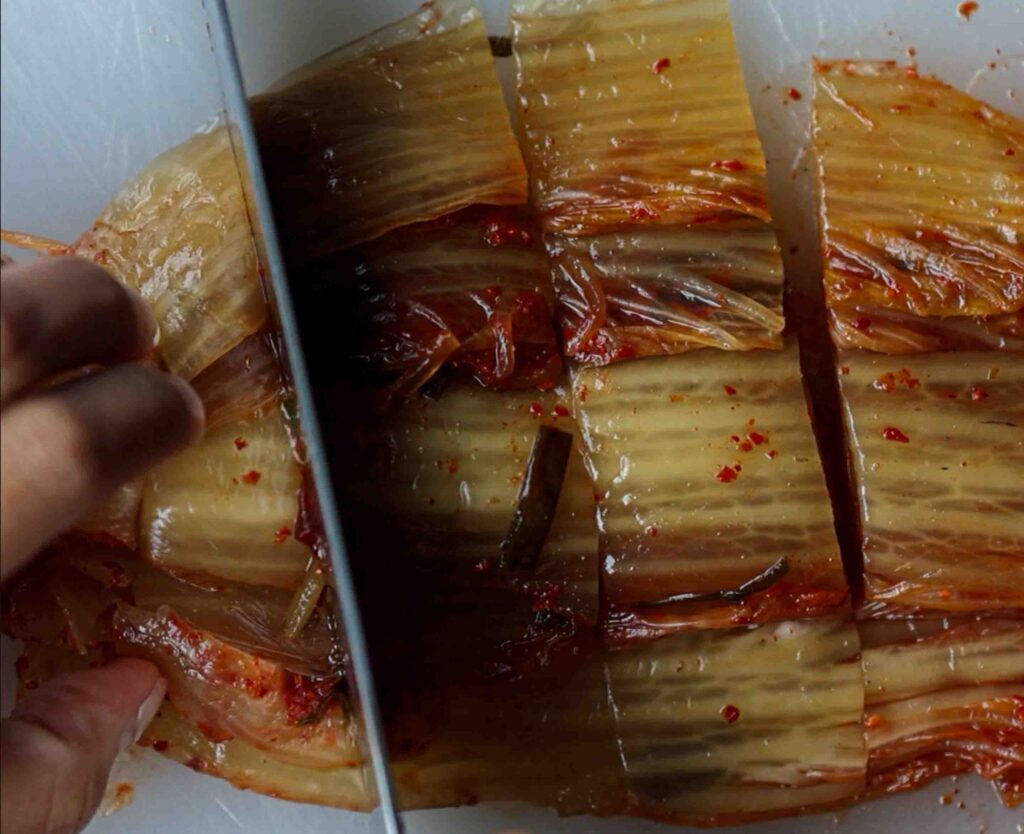
- Sesame Oil. Toasted sesame oil (not the cold pressed kind) will add just a touch of richness to this simple and humble dish. A little goes a long way, so you won’t need a lot. You can find my favorite Korean sesame oil here. If you don’t have sesame oil, you can simply add an extra helping of toasted sesame seeds as garnish.
- Gochugaru. Gochugaru or Korean pepper flakes provide both heat and a sweet smokiness to the kimchi sauce. You can also modify the spice level with the kind and amount of gochugaru you add to your kimchi noodles recipe. Sometimes, if you look closely at the packaging of the gochugaru you purchased, it will tell you just how spicy it is! If you can’t get your hands on gochugaru, you can substitute with more gochujang (to ensure the correct and desired depth of flavor), while reducing the amount of sweetener to compensate for the sweetness of the paste.

- Gochujang. Gochujang or Korean pepper paste provides intense umami flavor (the paste is made of fermented soybeans), more heat, and a little sweetness. If you don’t have gochujang, I would just add more gochugaru and a little more sweetener.
- Cucumber. The cool and crunchy cucumber provide color, texture, and a welcome “break” from all the heat contained in the kimchi and kimchi sauce. There really is not good substitute for cucumber, but if you really don’t have any, you can also top your noodles with julienned lettuce or other crunchy, raw green.
- Maple Syrup. You can substitute your favorite unrefined sweetener: brown rice syrup, coconut sugar, date sugar, etc.
- Rice Vinegar. Again, feel free to substitute with your favorite vinegar, one that’s naturally sweet, like apple cider vinegar, raspberry vinegar, etc.
How to Make this Kimchi Noodles Recipe.

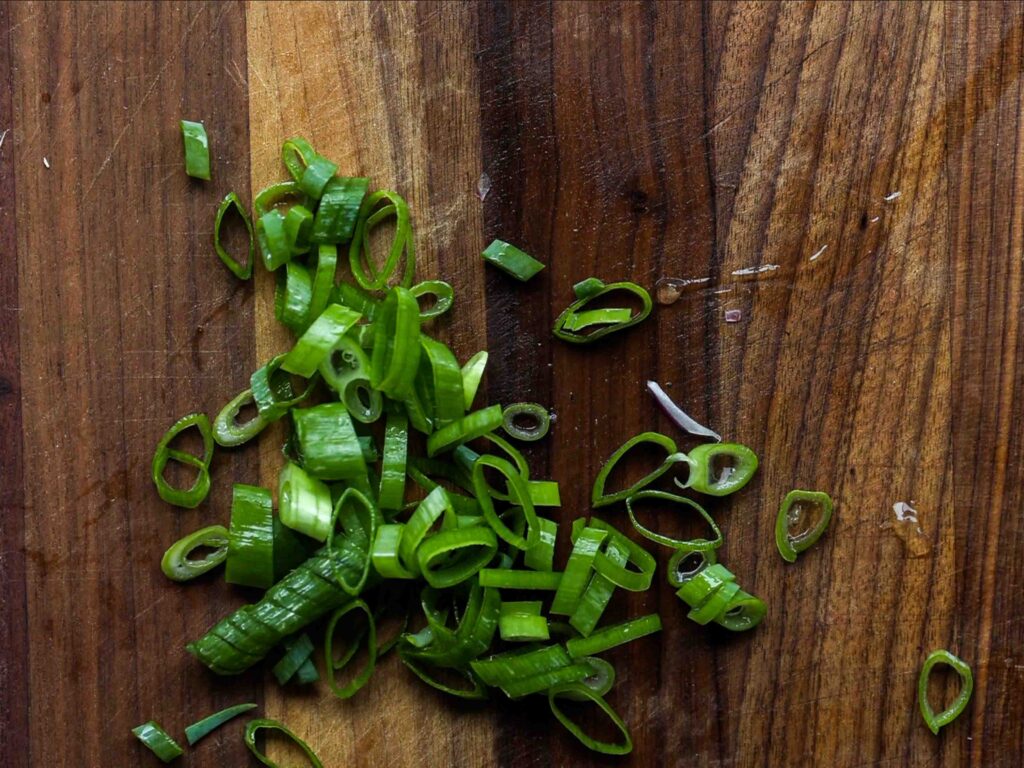
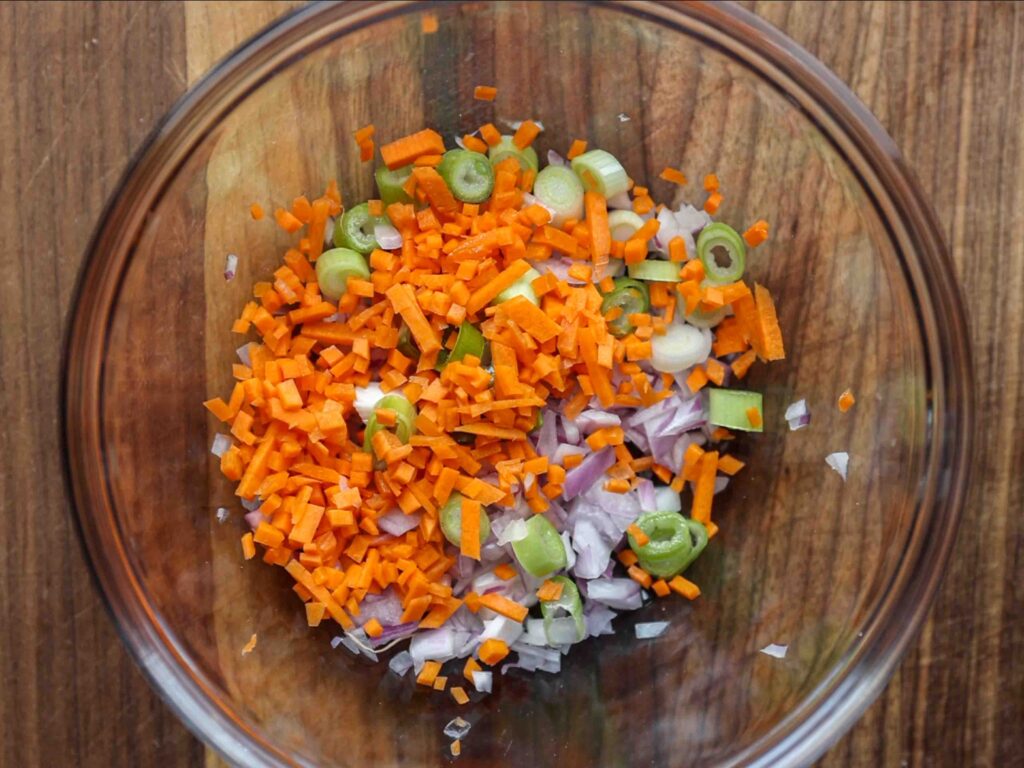
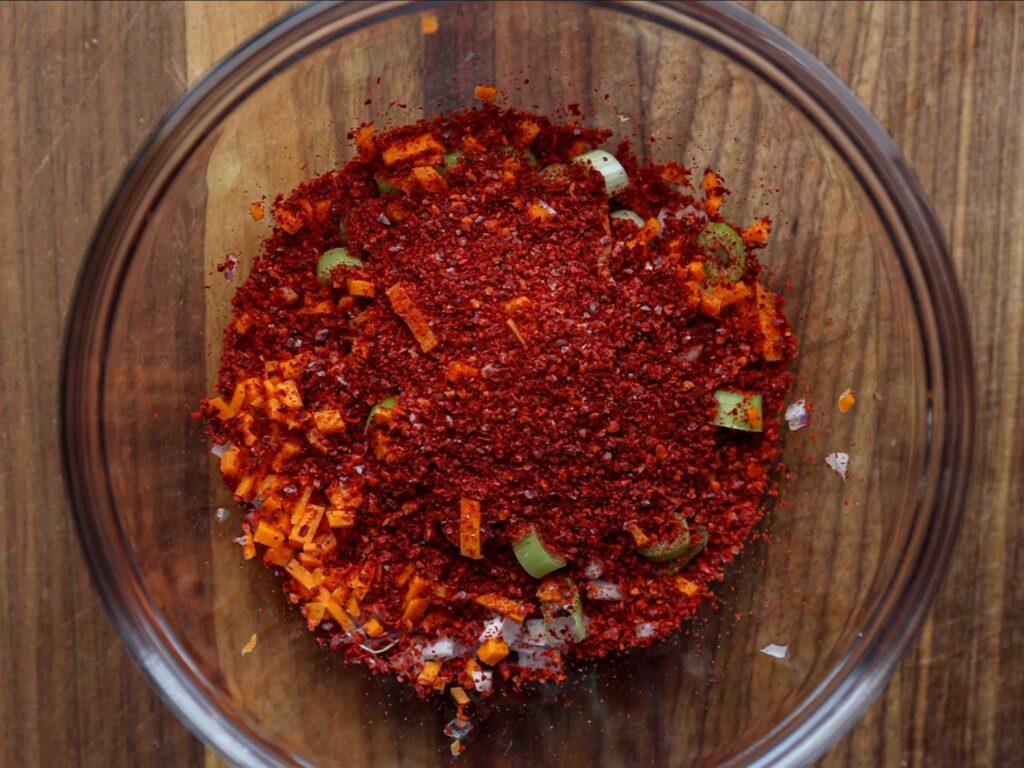
Other than how freaking delicious this recipe is, especially for hot summer weather (though I would NOT judge you for eating this on chilly days either), one of my favorite things about this kimchi noodles recipe is how freaking easy it is to make. But, whether this is your first time making kimchi noodles or your 76th time making this recipe, it’ll always taste amazing.
The first thing you want to do is get a small or medium pot of water on the stove over high heat. While you’re waiting for your water to boil, make the kimchi sauce by stirring together all the sauce ingredients:
2 tbsp gochugaru
2 tbsp gochujang
2 tbsp soy sauce
2 tbsp maple syrup
1 tbsp rice vinegar
2 tbsp toasted sesame seeds
1/4 cup small diced carrot
2 tbsp sesame oil
1/4 cup chopped green onions
1 cup chopped kimchi, plus 2 tbsp of kimchi juice
Stir the above ingredients until well-combined and set it aside.
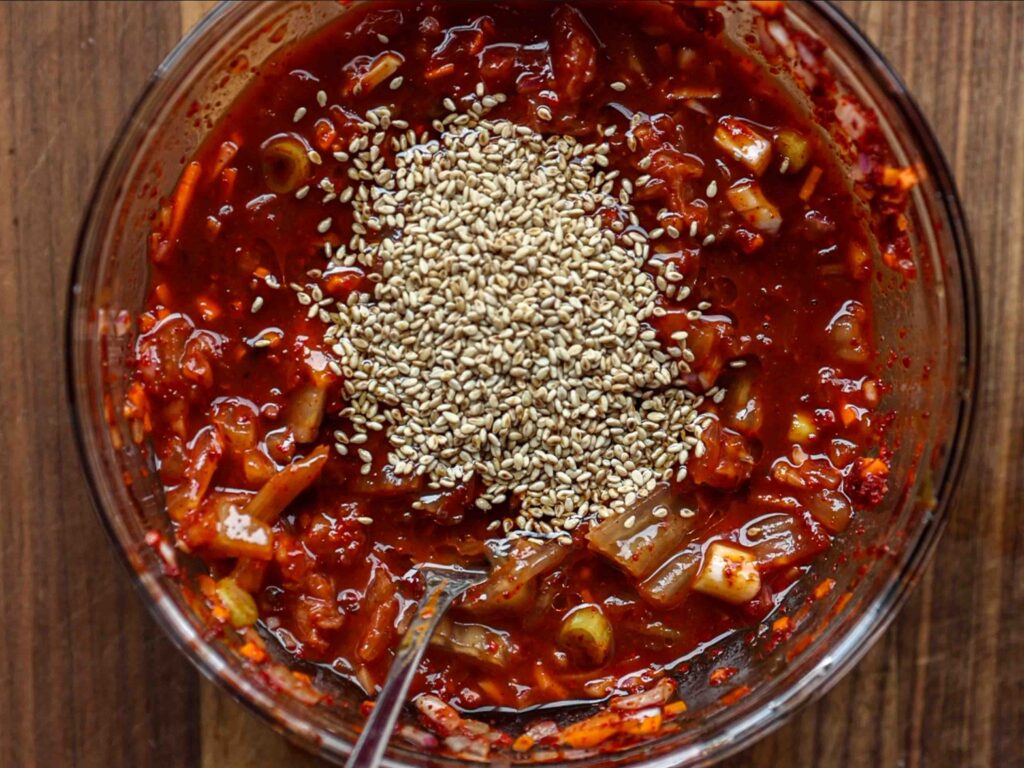
Then, cook your noodles according to the directions of the package. Usually, somyeon takes only a few minutes to cook, so I do not recommend walking away unless you have a timer on. Transfer noodles to a colander and drain while rinsing the cooked noodles under cold water (to make sure they don’t overcook). Then, place the drained noodles into a large bowl, together with the kimchi sauce. Using your hands (ideally) or chopsticks, stir vigorously to ensure the noodles are evenly and well-coated with your sauce.
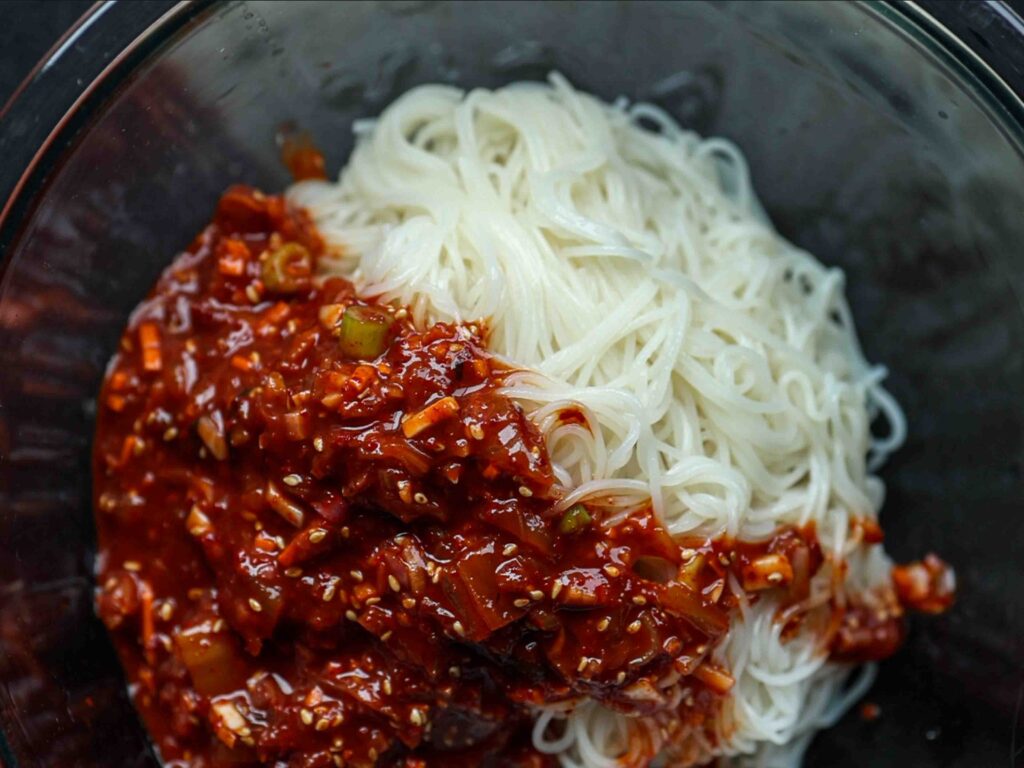
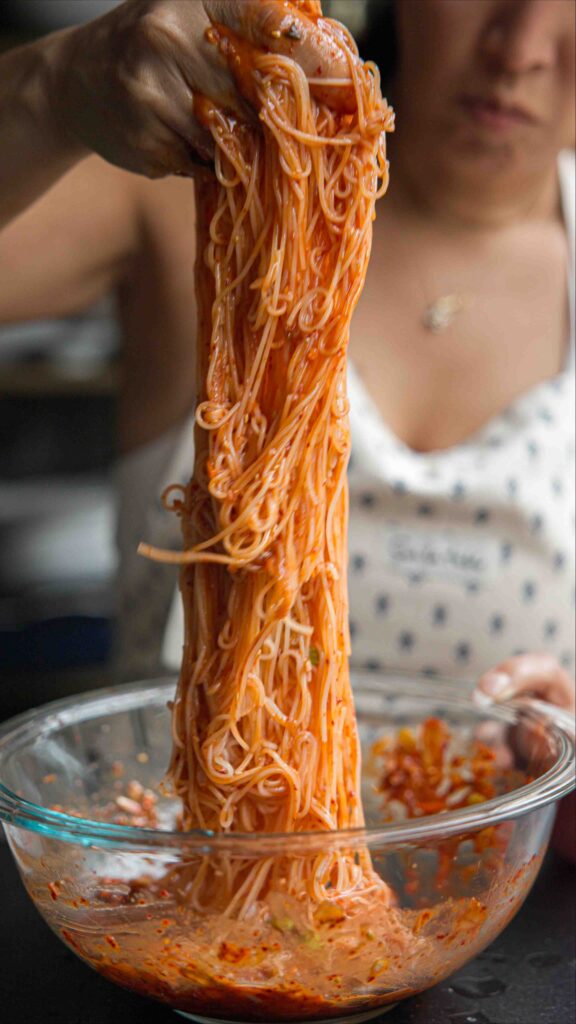
Place more chopped kimchi and julienned cucumber on top of the noodles, and garnish with toasted sesame seeds, a drizzle of toasted sesame oil, chopped scallion greens, and a couple cracks of black pepper.
And voila! You have just NAILED this kimchi noodles recipe!
Fun Add-Ons to this Kimchi Noodles Recipe.
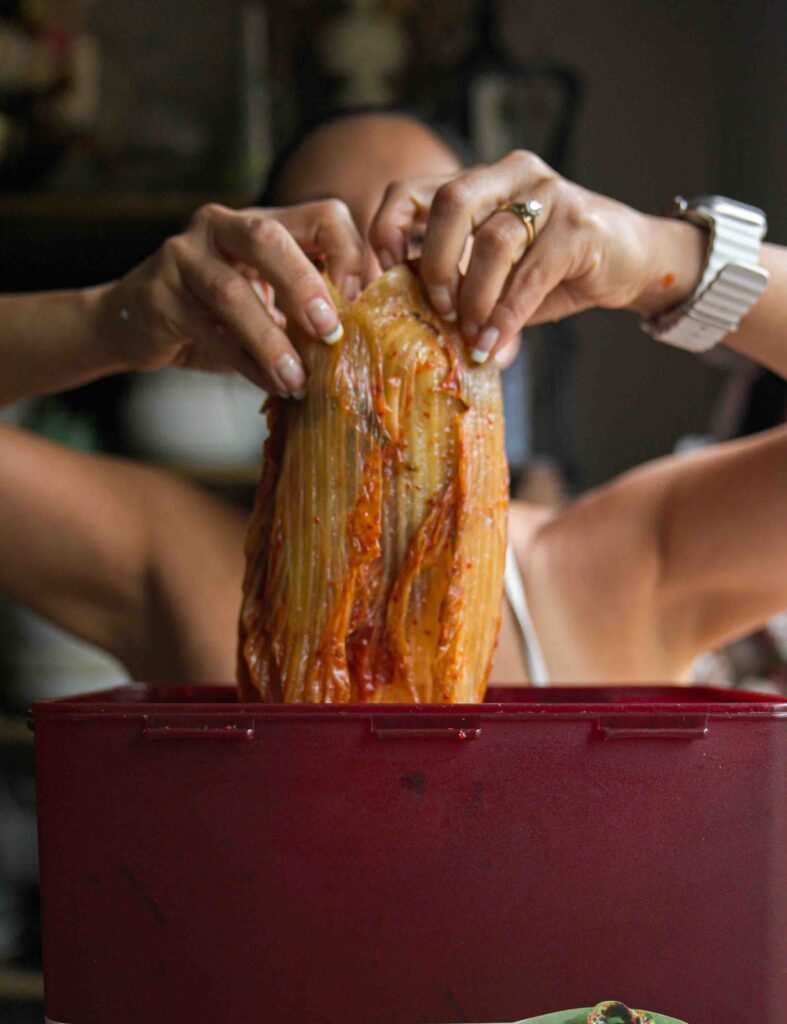
Look, I tried to keep this recipe lean and mean, so that you can make it with the bare minimum. However, if you’ve got time on your hands and a few more items in that fridge, here are some fun “add-on” ideas for this kimchi noodles recipe:
- Fish Sauce. Replace a tablespoon of soy sauce with vegan fish sauce.
- Bok Choy. I’m not personally a fan of bok choy, but if you are, top your noodles with some steamed bok choy to make them FANCY.
- Crispy Tofu. Look, don’t blame the fact that these are vegan for having less protein–the original recipe for kimchi noodles (vegan or not) doesn’t contain lots of meat. But, if you’d like to add some protein to this dish, I highly recommend crispy tofu, sliced up into batons.
- Perilla Leaves. What are perilla leaves? They are sometimes referred to as “sesame leaves” and look a lot like “shiso leaves.” They are minty and nutty and a little sweet all at the same time. They are rather delicate leaves but can be ribboned up as a lovely herby garnish for this kimchi noodles recipe. You can find them at the Korean grocery store.
Frequently Asked Questions.
Can I make this kimchi noodles recipe gluten-free?
Yes, you can replace traditional Korean wheat noodles with a gluten-free rice noodle and use gluten free soy sauce, gochujang, and kimchi to keep this entire recipe gluten free.
How long can I store my kimchi noodles?
Kimchi noodles are meant to be eaten immediately. The longer you wait, the soggier and mushier your noodles will become.
Are kimchi noodles healthy?
Because the kimchi noodles are served cold, you are not cooking out all the healthy probiotics contained in the kimchi. In addition, this vegan version is cholesterol free and relatively low in fat.
Recipe Card.
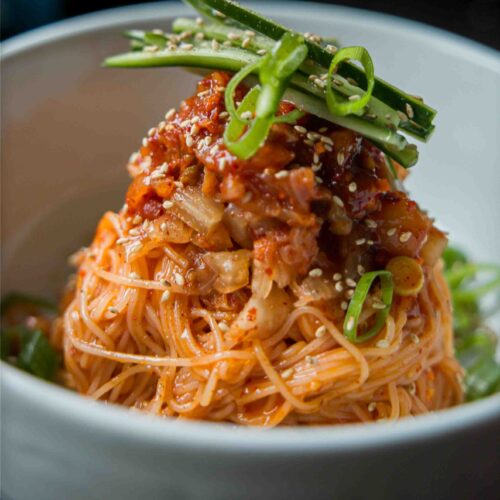
15-Minute Spicy & Cold Bibim Kimchi Noodles
Ingredients
- 400 grams somyeon (thing Korean wheat noodles)
- 2 tbsp gochugaru
- 2 tbsp gochujang
- 2 tbsp soy sauce
- 1 tbsp rice vinegar
- 2 tbsp maple syrup
- 2 tbsp toasted sesame seeds, plus more for garnish
- 2 tbsp toasted sesame oil, plus more or garnish
- 2 tbsp chopped green onions, plus more for garnish
- 1/4 cup diced red onion
- 1/4 cup small diced carrot
- 2 cups chopped vegan kimchi, plus kimchi juice
- 1/2 cup julienned cucumber
- 1 tsp black pepper
Instructions
- Bring a medium pot of water to a boil. While the water is heating, make the sauce: stir together gochugaru, gochujang, soy sauce, vinegar, maple syrup, toasted sesame seeds, toasted sesame oil, green onions, red onion, carrot, and 1 cup of chopped kimchi in a small bowl. Set aside.
- Cook noodles according to package instructions (cook in boiling water for 3 minutes). Remove from water and rinse under cold water to stop them from overcooking. Drain and place in a large bowl.
- Add the sauce and stir vigorously, until the noodles are evenly and well-coated. Divide noodles into four servings. Top with remaining kimchi and julienned cucumber. Garnish with sesame seeds, scallion greens, a drizzle of sesame oil, and cracked black pepper.




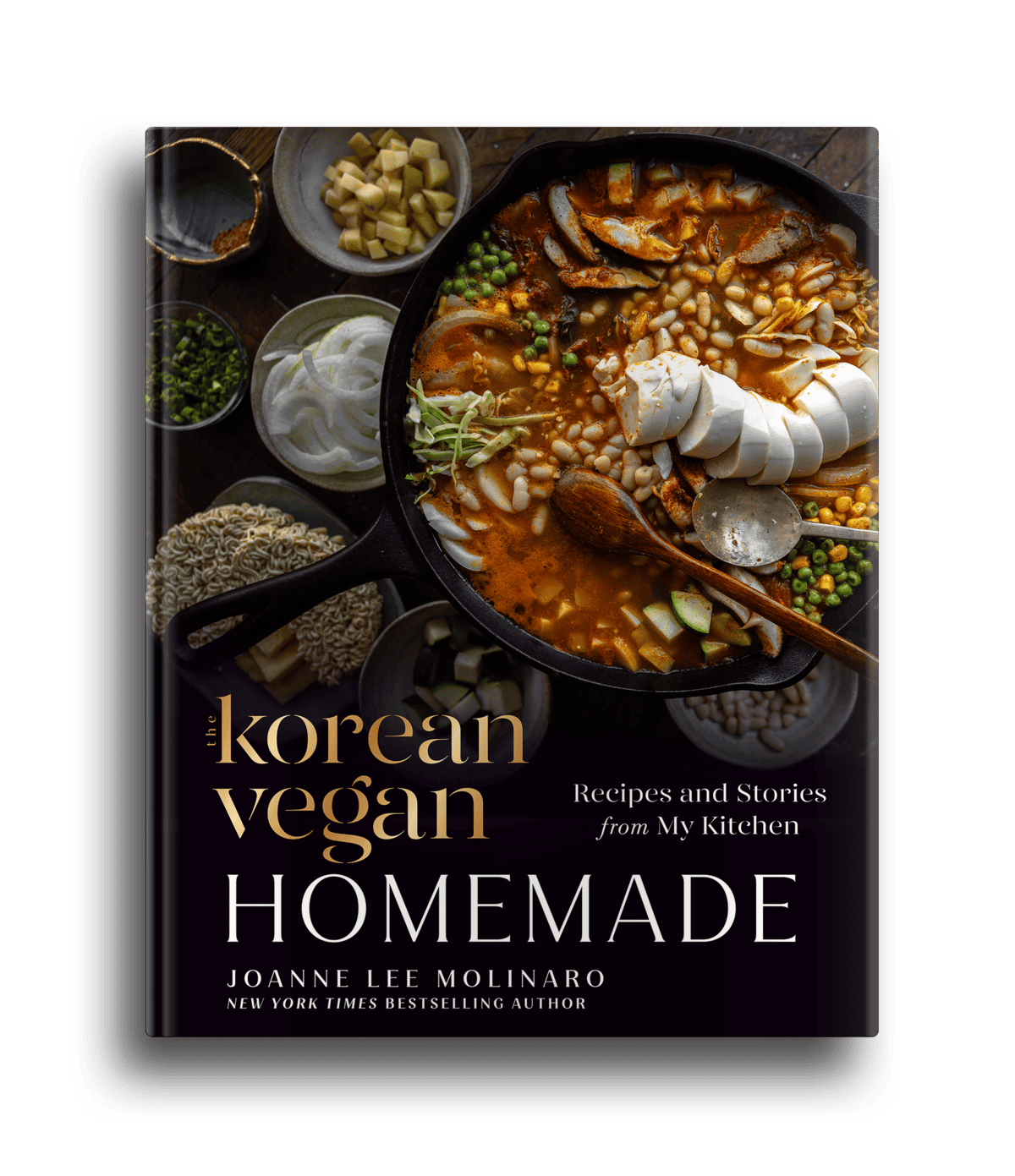
This was super easy to put together and super super tasty. I subbed the somyeon for gf rice noodles since it was all I could find but it worked just fine! :))
I love Korean food, but it’s really hard to find good vegan and gluten-free Korean restaurants near me. But I don’t need to worry about that anymore, because these were the BEST cold noodles I’ve ever had and they only took 10 minutes <3 <3
I added a 1/4 c of diced tofu for extra protein and it blended perfectly into the sauce
Can you use japchae noodles instead of rice or wheat ones?
It’s also quite delicious if you top it with crushed roasted seaweed!
YASSSS!! I did this the next day with my parents and it was OH SO GOOD!!!